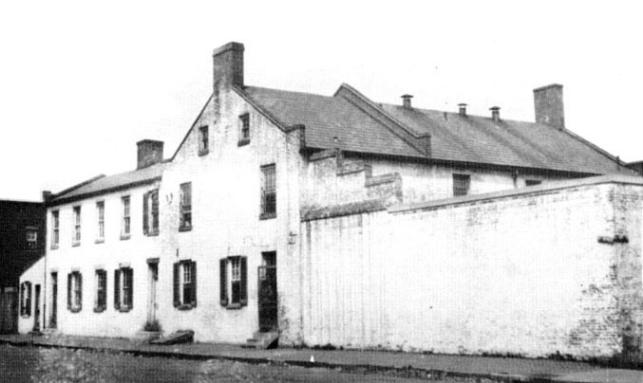Slaves in the Alexandria Jail, 1861

For the first year of the Civil War, the Lincoln administration held out hope of reuniting the Union without total war. This, and fears of alienating the slave-holding border states, made the U.S. government continue to respect federal and state laws which kept most African Americans in slavery. In fact, many army field commanders returned runaway slaves to their owners under the fugitive slave law still in force. But the soldiers and many politicians became increasingly angry and dissatisfied with the situation as the flood of fugitives increased, and the Confederate armies employed the labor of the remaining slaves.
The following article, from the (Washington) National Republican of January 20, 1862, was taken from a letter addressed to Massachusetts’ anti-slavery Senator Henry Wilson. It expresses outrage at the poor conditions and inhumanity of treatment of slaves in the Alexandria Jail, even under federal occupation. It points out that the actions of the Union authorities at that date were actually propping up slavery. It also makes clear that the jail functioned much as a low-class dog pound would today—runaway slaves were captured and clapped in a cell until their owners appeared or, for a fee, owners could simply drop off slaves for safekeeping while out of town, etc. The passage below does mention a few names: slaves Cynthia Brent and Benhood (or Ben Hood); and owners Mr. Close, Mr. Swan and Mrs. Kitson.
THE NEGROES AT ALEXANDRIA
In the Senate, January 14, Mr. Wilson read the following portions of a letter addressed to him by Dr. Samuel G. Howe:
"I thank you for your work on behalf of the poor fugitive slaves confined in the jail here….
Last June I tried in vain to do something for these victims of our impolicy. I pleaded with one member of the Cabinet to do something for them; and described the condition of thirty-five men, women, and children then held in bonds by the United States marshal for the benefit of their owners….
But you have appealed to the great heart of the people, and the will cheer you on by a shout of indignation at the atrocities perpetrated under the very walls of the Capitol.
The same atrocities are practiced under the same authority in the jail at Alexandria, which I lately inspected. The building is a wretched one, totally unfit for a public prison. It seems to have been built in the days when accused persons were considered as public enemies, and to be caged like wild beasts. The cells are narrow, dark, and damp, and the rings and staples fixed in some of the walls tell their own story. The internal arrangements are very bad; and the general condition of the house is filthy and noisome to the last degree. Such a jail would be presented by the grand jury in any Northern city as an intolerable nuisance. The system of administration is disgraceful to any State claiming to be Christian and civilized. The jail is rented out to an individual for $400 a year, who hires a turnkey and other assistants, and boards the prisoners for thirty-five cents a day.
In the case of negroes who are arrested for being without free papers or passes, the board is paid by the master when he comes for them. If no claimant appears, and the poor fellow cannot prove that he is free, he is kept until the fees amount to a sum, when he may be sold to satisfy the claims of injustice.
Among the prisoners are nineteen whose only offence is that of fleeing from those who claimed to be their masters. Some of them have been confined several months; but, in spite of all the horrors of the place, they do not want to be sent back to their masters, because they fear ‘being sold down South.’ I saw fifteen of these unfortunate creatures, and spent time enough to ascertain the exact truth respecting their history and condition. I examined what are called ‘the books,’ and such wretchedly written memoranda respecting their commitment as exist.
I had a peremptory order from the commandant upon the jailer to give me all information, and he did so, evidently being in great fear of the authorities. I conversed with the prisoners in his presence, and then alone; so that I got pretty good evidence….
Let me note some of these cases to show how loosely injustice is administered in the sacred soil of Virginia by the United States authorities. You may infer what must have been the former state of things.
The records show that, on the 9th of August, 1861, Cynthia Brent was taken up by somebody, and put in the jail as a supposed runaway slave. On the 29th of August, a Mr. Close, who had owned the girl’s father, obtained an order for the chattel, and took her away. She escaped from him, but fell into the hands of her master, Mr. Swan, who brought her, on the 10th of September, and imprisoned her on his own authority, and she is still in prison.
On the 16th of August, 1861, came one Mrs. Kitson—she ought not to have any Christian name—and claiming four fugitives—two women, one ‘boy,’ and one child—as her slaves; and, as she paid their board, she took them off, probably to sell them to other ‘beasts of burden.’
June 12, 1861, was brought in Benhood, a fugitive. He was kept nearly five months, and probably began to think he was safe; but, on the 6th of November, one Fleming, claiming to be agent of his master—now himself a fugitive—came with an order from General Montgomery, and carried poor Benhood off to a known fate in unknown parts.
The persons claiming to own these human beings are, for the most part, rebels, and have fled; the United States acts as jailor, and takes care of their chattels during their absence."
|
Friends of Freedmenís Cemetery |
|
April 29th, 2007


